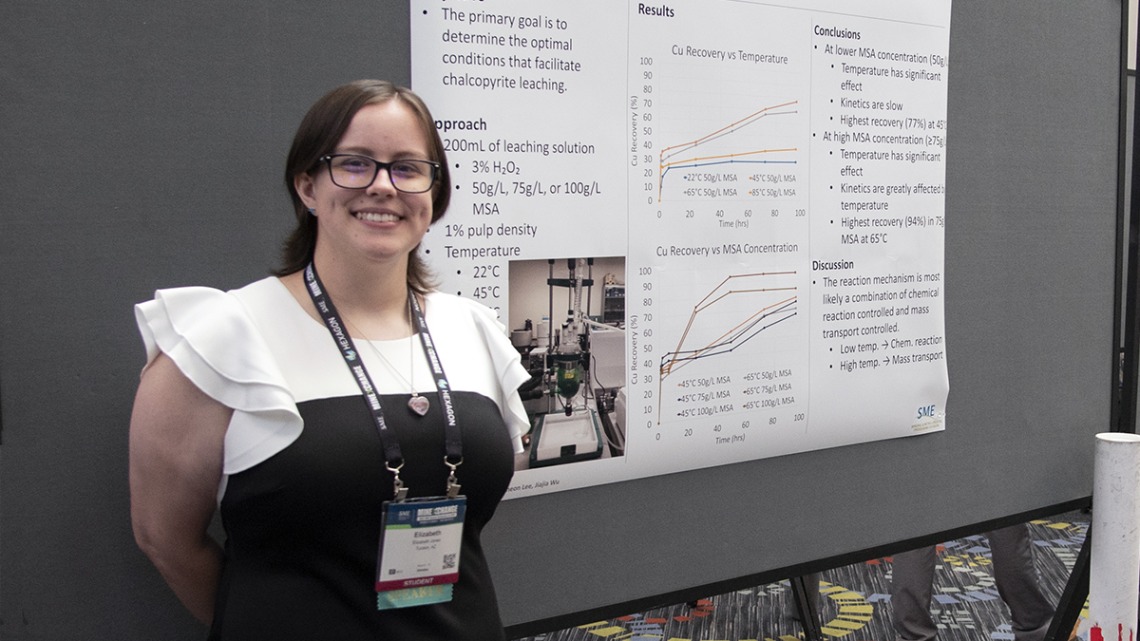Student Researchers Move Meaningful Scientific Inquiry Forward

Elizabeth Price at a poster presentation at MINEXCHANGE 2021
How do you envision research? Some think of the lone scientist working tirelessly in the lab, obsessed with finding the elegant solution to a problem. Others imagine a team of white-coated researchers diligently conferring in front of a white board until the group comes up with the answer. In reality, research requires several people working over long lengths of time to discover, test, hone, test, expand, test and eventually find potential solutions to scientific and technological challenges.
The experience of University of Arizona student Elizabeth Price (formerly Elizabeth Jones), who graduated in spring 2022 with a master’s in mining engineering, illustrates this. Dr. Jaeheon Lee is a UArizona associate professor of mining and geological engineering and was Price’s adviser. When Price approached him for a thesis research project, he had an intriguing one waiting for a student researcher to tackle.
Research builds on earlier investigations
Just as Price started her master’s studies, then doctoral candidate Junmo Ahn was investigating ways to better extract copper from chalcopyrite, one of the most abundant copper resources, but which is a difficult material from which to get copper. Ahn, now an assistant professor in Korea, experimented with several chemicals to find one that more effectively leaches chalcopyrite, melting it away to leave behind the copper.
Lee needed someone to further Ahn’s work. Price took one of Ahn’s better chemical combinations and methods and refined it. “What we are trying to do is find the ideal conditions that will leach chalcopyrite,” she says.
Now that she has graduated, another researcher will need to adjust those conditions for the most efficient way to leach chalcopyrite at the scale of mineral processing by mines. If successful, this leaching method could replace smelting to extract copper from the mineral, an expensive and environmentally unfriendly process. “Essentially, we’ve found some viable lab-scale conditions and now it needs to be taken to the next level,” says Price.
Her work helped confirm and extend Ahn’s foundational activity. But research isn’t always linear. Sometimes a researcher’s work causes other interesting questions, like “what if we do this instead of that?”
Students take old research in new directions

Maxwell Drexler presents his research at MINEXCHANGE 2021
Maxwell Drexler met graduate student Molly Radwany when both used UArizona labs for leaching experiments. For her master’s thesis, Radwany worked to characterize valuable vanadium in ore deposits. Knowing that a significant amount of vanadium is left behind in the leaching process, she sought methods that would efficiently extract the metal from mineral deposits.
“When Molly started her work (in the lab), I was curious about it and was already around,” Drexler explains, “so it was easy to join in and help. We worked quite well together in the lab. It was nice for both of us to bounce ideas off each other when uncertain about a procedure.”
With his interest in geometallurgy—a discipline that fuses geology and extractive metallurgy—Drexler, with help from his adviser Dr. Isabel Barton, wanted to piggyback on Radwany’s work. He used a different type of examination technique, transmission electron microscopy, to characterize vanadium-bearing phyllosilicates before and after leaching. “The technique is pretty much unheard of in mining,” he explains, “which is why I collaborate with space scientists—they are the experts.”
Thinking of what future student researchers can do to move his work forward, he adds, “It would be neat to see the technique provide us some useful information and for some others in metallurgy/mining to make use of it.”
Certainly, student researchers learn to collaborate while adding skills in conducting experiments, using equipment and writing papers for publication. Their real-world investigations add to the body of work that can answer questions in basic science as well as suggest improvements and applications in mining.
“Having a better understanding of the fundamentals always helps advance science and engineering in the long run,” says Barton, assistant professor of mining and geological engineering.
Students do the heavy lifting at research universities like UArizona
In envisioning research at a university, some might assume that faculty spend more time on their research than with students. But faculty rely on student researchers to move science forward in meaningful ways.
“The goal of the university is to teach students in the classroom and in the laboratory,” says Lee. “I also work in the laboratory with students with my lab coat and safety glasses on, but students are the ones who carry out most of the work. Faculty members have many great ideas to investigate in the university laboratory, but it’s extremely difficult to perform without students.”

